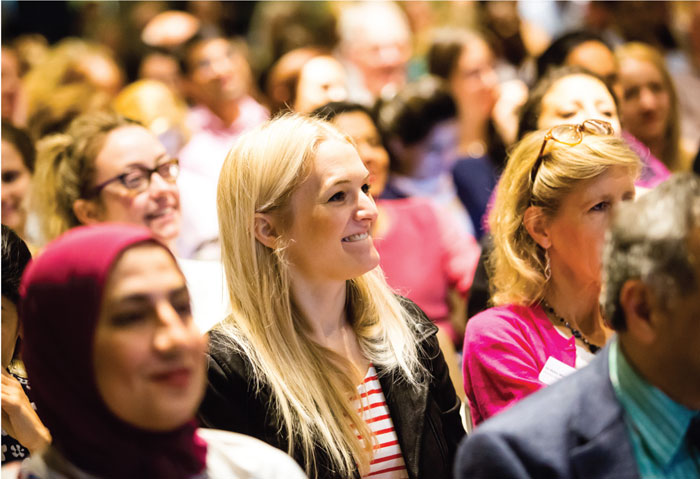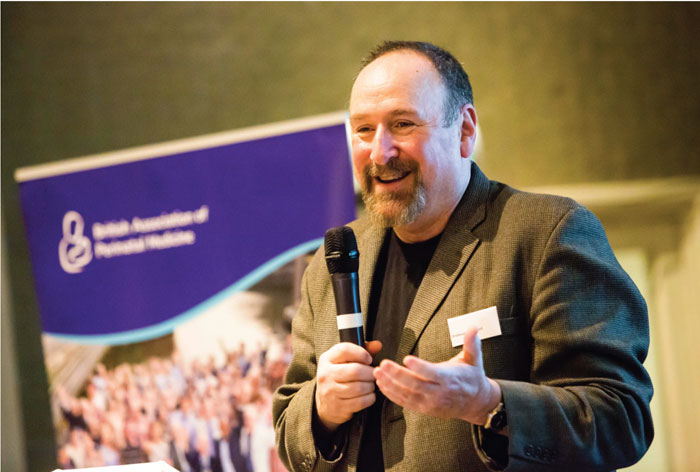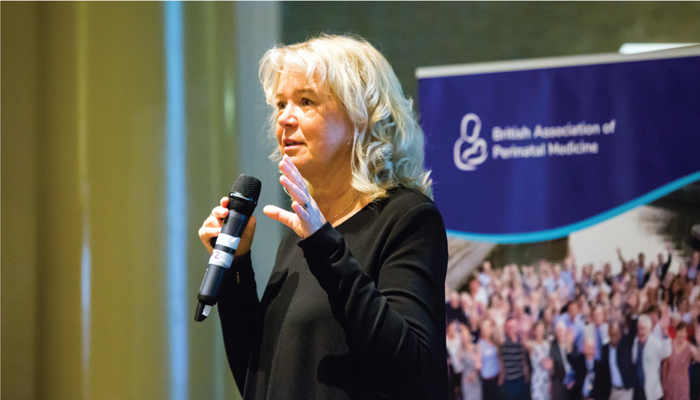Experts share research and quality improvement initiatives
A report of the 2018 BAPM annual conference in Leeds on 27-28 September.
Dr Helen Mactier
Princess Royal Maternity Hospital
Dr Sarah Bates
Great Western Hospital
Dr Elaine Boyle
University of Leicester
Dr Sue Papworth
Royal Gwent Hospital
Kate Dinwiddy
Chief Executive, BAPM
The 2018 BAPM annual conference welcomed 250 attendees to The Met Hotel in Leeds on 27-28 September. The conference brings together those working in neonatology to share the latest research updates and quality improvement initiatives.
Dr Amanda Drake, Consultant Paediatric Endocrinologist at the Royal Hospital for Sick Children in Edinburgh, presented the work of her research group at the University of Edinburgh, exploring the concepts of early life programming. Her research has focused on the role of DNA methylation and disease via imprinting disorders. Such problems are well recognised in neonatal practice, for example Prader-Willi, Angelman and Rett syndromes, and transient neonatal diabetes mellitus. She explored the idea of whether environmental factors can alter DNA methylation in offspring and subsequently alter behaviour. She showed evidence in rat studies that altered methylation affects mothering skills. Human studies have given more complex results and haven’t yet provided convincing evidence of an environmental effect on behaviour.
Dr Drake touched on the role of different methylation of genes in preterm infants being involved in central nervous system function. Ongoing work is studying whether different methylation in preterm infants persists or declines with age and is therefore immaturity-related.
Dr Kathryn Johnson, Consultant Neonatologist at Leeds University Hospital, gave an update on the results of the Elfin randomised controlled trial which looked at the role of supplemental lactoferrin on rates of late onset infection (LOS) in preterm infants <32 weeks’ gestation. Secondary outcomes were rates of necrotising enterocolitis (NEC), bronchopulmonary dysplasia (BPD) and retinopathy of prematurity, as well as intensive care days and length of hospital stay. There has been increasing recognition of the immunogenic role of breast milk in addition to its nutritional one. Lactoferrin, a glycoprotein present in a high concentration in colostrum and expressed milk, has known antimicrobial actions such as cell membrane disruption and inhibition of growth of bacteria, viruses and fungi. Early trials had shown that bovine lactoferrin, which bears 70% homology with the human form, had a positive impact on infection rates. The Elfin trial recruited 2,200 infants in 37 centres. The rates of LOS were not statistically different between groups (28.9 vs 30%) or in the secondary outcomes of NEC or mortality. The study therefore concluded that supplementation with bovine lactoferrin does not reduce LOS, mortality or morbidity. Dr Johnson discussed that there may be overlooked factors contributing to this result, such as whether lactoferrin works in symbiosis with other factors in expressed breast milk such as pro- or prebiotics.

The theme of this year’s BAPM conference: Excellence in Perinatal Care.
Dr Edile Murdoch, Consultant Neonatologist in Edinburgh and Clinical Lead in Lothian for the Being Open project, spoke about being open in perinatal care after significant adverse events (SAE). Dr Murdoch spoke about how it is so important to do this well, to avoid families experiencing complex bereavement and attachment problems, and to help staff avoid reduced resilience, reduced confidence, anxiety and stress.
Being open is a key part of guidance from MBRRACE-UK, Each Baby Counts and the Perinatal Mortality Review Tool and yet still it seems we aren’t doing this well yet. The Being Open project launched in Lothian with extensive scoping, listening to families, patients, staff and process mapping with multiple staff groups. This identified issues including delay in alerting families to SAEs, poor communication of the process, delay in sharing report outcome with families, together with a negative culture/blame culture resulting in difficult staff experiences. Psychological input and simulation training were implemented to help overcome some of these challenges. “Subtle changes in language can have a profound effect on patients,” said Dr Murdoch.
Dr Murdoch reviewed the practical changes they have implemented within the adverse event pathway, resulting in a substantial cultural change and improved family and staff experience. Managing this process well maps to many of the BAPM Neonatal Service Quality Indicator targets, not least around involving families as partners in care. Getting this right really makes a difference for families in the long term.
Dr Ronny Knol, Consultant Neonatologist at Sophia Children’s Hospital in Rotterdam, gave a review of the physiology of transition at birth, with much emphasis on the importance of establishing breathing and delivering thermal care during delayed cord clamping (DCC). The evidence base surrounding DCC was also reviewed, with a focus on the new meta-analysis (including the Australian Placental Transfusion Study) showing a relative risk of 0.68 for mortality. The challenges of providing resuscitation and stabilisation during DCC were discussed including the difficulties of cord length, which can prohibit delivery of other techniques and interventions. Dr Knol then discussed the development of equipment to deliver cord-intact stabilisation with respiratory function monitoring. Physiological parameters defined for ‘stability’ can dictate when the cord can be clamped. The ABC1 (Aeration, Breathing, Clamping) feasibility study performed this technique in a group of preterm babies, with average time to cord clamping over four minutes and a mean admission temperature of 36°C. The now underway ABC2 trial compares this physiological-based cord clamping technique to standard care (30-60 seconds of DCC) with outcome being stabilisation time/non-inferiority. The planned ABC3 trial will consider outcomes of intraventricular haemorrhage, NEC and death. DCC and its implementation changes the way obstetric and neonatal teams work together, Dr Knol said.

Professor Roger Soll gave an update on BPD.
Professor Roger Soll, Professor of Neonatology at the University of Vermont College of Medicine and President of Vermont Oxford Network, gave two talks at the conference. In his first lecture – the BAPM Founders Lecture on Collaboration for Quality Improvement – delegates heard how to broaden the experience of collaborative working in the UK. Specifically, the audience was encouraged to think about how data are used, and the value of benchmarking. In seeking improvement we need first to understand current quality and identify gaps before introducing change and monitoring improvement. We also need to be able to interpret variation in outcomes and think about the difference between research data and, perhaps more clinically relevant, quality data. Slow uptake of the seminal work of Ignaz Semmelweis in the mid-19th century should remind us that quality improvement needs team working, with the four key habits of change, evidence-based medicine, systems thinking and collaborative learning. Evidence-based medicine tells us what to do but, more importantly, evidence-based practice tells us how to do it. Healthcare professionals are better engaged in quality improvement now, but there is no room for complacency and we should not forget that everyone can be better.
Professor Soll also gave an update on BPD, with a reminder of its long-term outcomes and the changing clinical and physiological definitions over recent years. Unfortunately, there are fewer therapies that are useful than not useful. There is no advantage to prophylactic administration of surfactant and volume-targeted ventilation may be helpful. Caffeine is effective, but investigation of medical treatments in general has been disappointing with no good evidence for diuretic use and increased cost for minimal effect with vitamin A. Postnatal steroids are the most potent treatment and the effects are better if given after seven days. Hydrocortisone requires further study. There is currently advice in the USA against using steroids because of the effects on development, but there is also an effect of BPD on development. There is still much to learn.
Day two of the conference started early with a choice of three practical sessions:
- Stabilisation/resuscitation next to mum led by Dr Anne Marie Heuchan and Dr Ronny Knol.
- Success in expressing breast milk led by Ms Gillian Gardiner.
- The NMPA (National Maternity and Perinatal Audit) sprint audit led by Dr Harriet Aughey and Dr Jane Hawdon.
Nikki Robertson, Professor of Perinatal Neuroscience at University College London, summarised issues around neuroprotection, reminding delegates that the incidence of hypoxic ischaemic encephalopathy varies between high and low income countries and that boys are more vulnerable. Current practice with respect to therapeutic hypothermia appears to be optimal, and studies examining lower temperature and longer duration have not showed benefit. Ongoing research is exploring the use of adjunctive therapies alongside hypo-thermia, with different therapies acting at different stages of the pathological process – acute, sub-acute and repair. In animal studies, azithromycin has been observed to reduce injury. Studies of allopurinol and pre-clinical studies of melatonin are in progress and there is an ongoing trial
of erythropoietin. The noble gases are being explored, with argon showing some promise. In piglets, remote ischaemic post-conditioning using cycles of ischaemia and re-perfusion appears to be protective, but needs further investigation. This is an exciting time with research working towards the ideal of tailored neuroprotection.

Professor Renee Flacking delivered the Peter Dunn Lecture.
Professor Renee Flacking, Uppsala University Sweden, gave this year’s Peter Dunn Lecture on promoting health and wellbeing for babies and their families in neonatal units (NNU), describing the critical importance of parental presence in the NNU, and how to facilitate this. Professor Flacking outlined huge variation in the duration of parental presence in the unit, despite the fact that continuous parental presence is associated with better neonatal outcomes. In some NNUs in Sweden parents are able to be with their preterm baby almost continuously from birth until discharge thanks to a variety of factors including:
- provision of family rooms
- beds (or at least comfortable, reclining chairs) for parents in close proximity to their baby’s incubator
- facilities for siblings
- parental expectation.
The audience was invited to consider how to make parents feel truly welcome in the NNU, and to reflect upon many things that we do, often without consideration for parents’ feelings. How often do we remember physical closeness, but forget emotional closeness for families? We should all be encouraged to use creative thinking in making positive changes to our practice, and “not let the vision of the
ideal prevent implementation of the possible,” she said.
In his presentation on drugs and the developing brain, Professor James Boardman, Professor of Neonatal Medicine at the University of Edinburgh, described the behaviour of women who use opioids during pregnancy and the UK increase in the number of newborn babies displaying signs of neonatal abstinence syndrome (NAS). Untreated heroin addiction in pregnancy can give rise to a number of dire consequences including intrauterine growth restriction, placental abruption, fetal death, preterm labour and a greater likelihood of the infant being taken into care. The vast majority of pregnant women in the UK are maintained on methadone but what are the effects of methadone exposure on the developing fetal brain in utero? Professor Boardman presented findings from a systematic literature review to look at childhood outcomes with the conclusion that methadone exposure results in neurodevelopment impairment and adverse visual outcomes. He also considered methadone vs buprenorphine maintenance; buprenorphine appears to give better outcomes for babies but may not be ideal for addicted mothers as they are less likely to stick to buprenorphine.
Dr Sam Oddie, Clinical Lead for the National Neonatal Audit Programme (NNAP) closed the conference by launching the 2018 NNAP report on admissions of babies for neonatal care in England, Scotland and Wales in 2017. This is discussed in greater detail in the Infant editorial on pages 216-17.
Or read this article in our
Tablet/iPad edition


